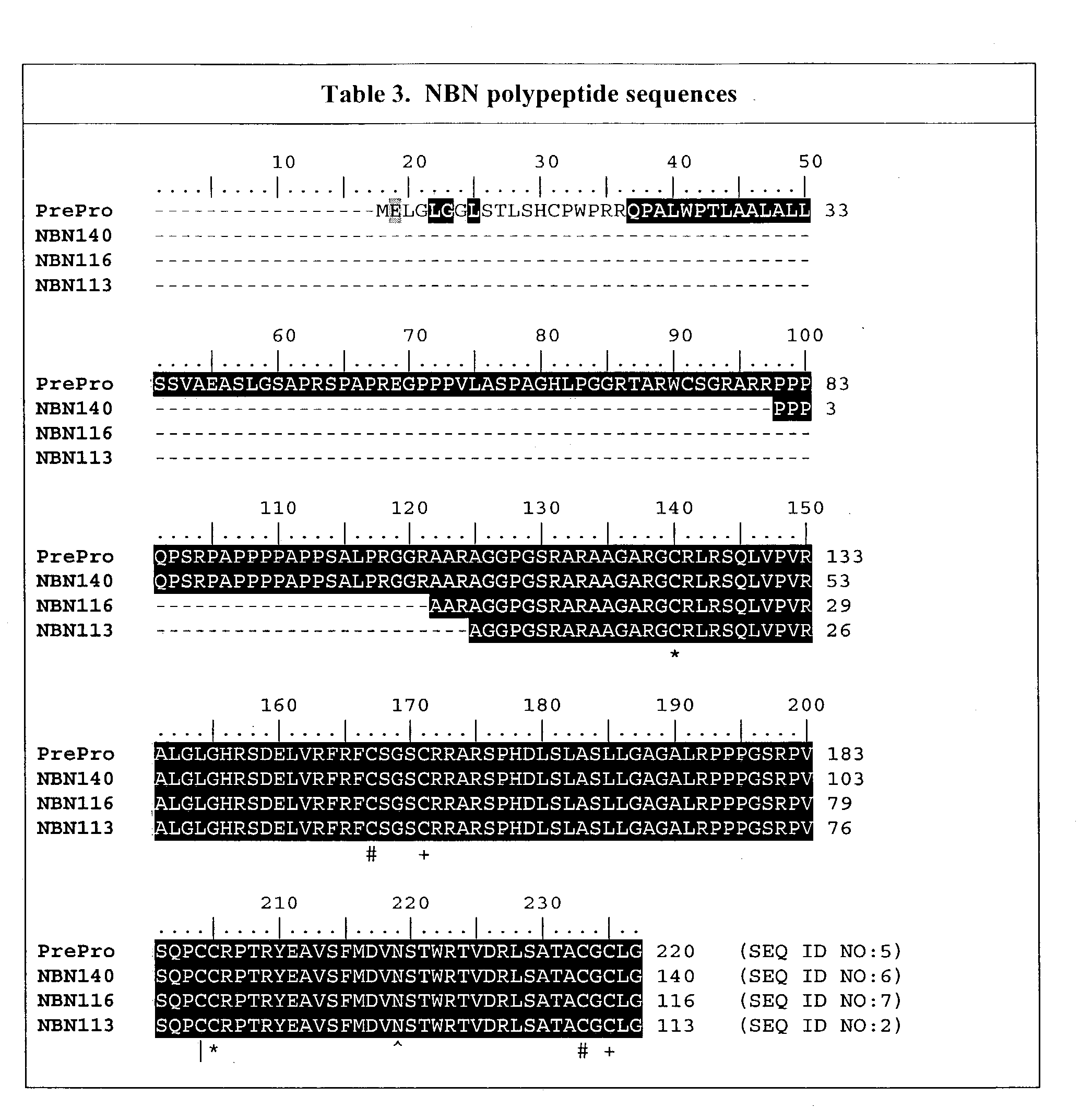Polymer conjugates of mutated neublastin
- Summary
- Abstract
- Description
- Claims
- Application Information
AI Technical Summary
Benefits of technology
Problems solved by technology
Method used
Image
Examples
example 1
Bioavailability of Amino-Terminal PEGylated Neublastin
[0220] CHO cell—and E. coli—derived recombinant neublastins were observed to be rapidly cleared from circulation if administered intravenously in rats. The proteins were below the threshold of detection in the serum following subcutaneous administration. To increase bioavailability of neublastin, PEGylated forms of mutated neublastin were constructed.
[0221] Because no lysines occur in the neublastin sequence, amine-specific PEGylation chemistries will result in PEGylation of a wild-type neublastin polypeptide at its amino terminus. Thus, for each neublastin dimer, two PEG moieties should be attached. Accordingly, PEG forms were first directly targeted to the amino-terminus through amine specific chemistries. Surprisingly, PEGylation of E. coli expressed wild-type neublastin, even with two 20 kDa PEGs attached, had little benefit on half life, indicating that a mechanism based clearance pathway was overriding the enhancement in ...
example 2
Construction of a PEGylated Mutated Neublastin (N95K)
[0222] The bioavailability of mutated neublastin forms PEGylated at internal amino acid residues was next examined. A series of four mutants replacing naturally occurring residues at positions 14, 39, 68, and 95, when numbered as shown in SEQ ID NO:1, were designed to insert lysines at selected sites in the sequence. These lysines would provide alternative sites for PEG attachment. These sites were selected using the crystal structure of GDNF (Nat. Struct. Biol. 4: 435-8, 1997) as a framework to identify surface residues. The persephin / neublastin chimera mutagenesis study (J. Biol. Chem. 275: 3412-20, 2000) was used to identify functionally important regions of the structure that should be avoided.
[0223] In order to express the wild-type neublastin gene in E. coli, syngenes were constructed with lower GC content and preferred E. coli codons. The syngene was cloned into two vectors, pET19b and pMJB164, a derivative of pET19b. In ...
example 3
Assessing the Potency of Internally PEGylated Mutated Neublastin NBN106-N95K in a Kinase Receptor Activation (KIRA) ELISA
[0258] The potency of PEGylated mutated rat neublastin was measured using neublastin dependent activation / phosphorylation of c-Ret as a reporter for neublastin activity in an ELISA that was specific for the presence of phosphorylated RET. NB41A3-mRL3 cells, an adherent murine neuroblastoma cell line which expresses Ret and GFRα3, were plated at 2×105 cells per well in 24-well plates in Dulbecco's modified eagle medium (DMEM), supplemented with 10% fetal bovine serum, and cultured for 18 h at 37° C. and 5 % CO2.
[0259] The cells were washed with PBS, and treated with serial dilutions of neublastin in 0.25 mL of DMEM for 10 min at 37° C. and 5% CO2. Each sample was analyzed in duplicate. The cells were washed with 1 mL of PBS, and lysed for 1 h at 4° C. with 0.30 mL of 10 mM Tris HCl, pH 8.0, 0.5% Nonidet P40, 0.2% sodium deoxycholate, 50 mM NaF, 0.1 mM Na3 VO4, 1 ...
PUM
| Property | Measurement | Unit |
|---|---|---|
| Fraction | aaaaa | aaaaa |
| Fraction | aaaaa | aaaaa |
| Mass | aaaaa | aaaaa |
Abstract
Description
Claims
Application Information
 Login to View More
Login to View More - R&D
- Intellectual Property
- Life Sciences
- Materials
- Tech Scout
- Unparalleled Data Quality
- Higher Quality Content
- 60% Fewer Hallucinations
Browse by: Latest US Patents, China's latest patents, Technical Efficacy Thesaurus, Application Domain, Technology Topic, Popular Technical Reports.
© 2025 PatSnap. All rights reserved.Legal|Privacy policy|Modern Slavery Act Transparency Statement|Sitemap|About US| Contact US: help@patsnap.com


